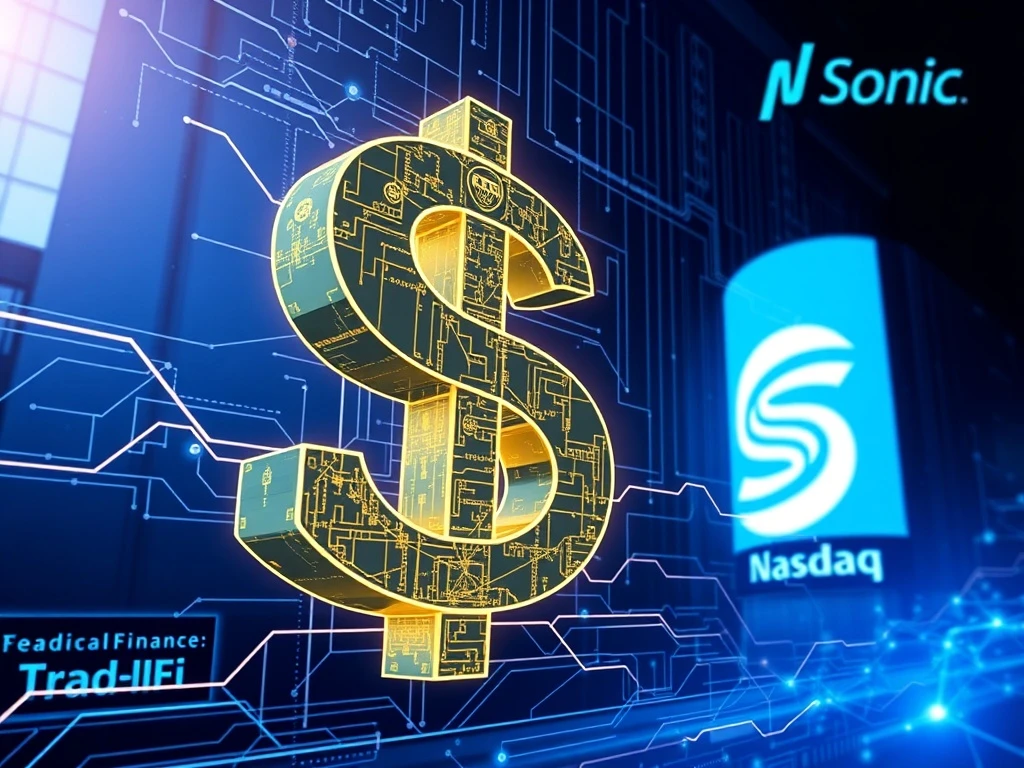Sonic Labs Unveils Ambitious $200M TradFi Integration Strategy

The cryptocurrency world constantly seeks new avenues for growth and mainstream adoption. Consequently, a groundbreaking development has emerged from Sonic Labs, the team behind the innovative layer-1 Sonic blockchain. They recently secured overwhelming community approval for an ambitious $200 million move into traditional finance (TradFi). This strategic initiative aims to bridge the gap between digital assets and established capital markets, promising significant implications for the broader crypto ecosystem. The bold plan involves creating a US-based company and launching a dedicated Crypto ETP, marking a pivotal moment for the project.
Unpacking the $200 Million Crypto ETP and Strategic Reserve
Sonic Labs’ recent proposal received nearly unanimous support. Specifically, 99.99% of S tokens from 105 wallets approved the initiative. This decisive vote signals strong community confidence in the project’s direction. The proposal also comfortably met the required quorum of 700 million S tokens, demonstrating robust participation.
The $200 million allocation of S tokens is strategically divided to maximize impact:
- Nasdaq PIPE Vehicle: $100 million in S tokens will establish a strategic reserve. This reserve supports a Nasdaq PIPE (Private Investment in Public Equity) vehicle. This move aims to attract institutional capital from traditional markets.
- S Token-Tracking ETP: Another $50 million will fund an S token-tracking Crypto ETP. A regulated, top-tier ETF provider, managing over $10 billion in assets, will issue this product. BitGo will custody the fund, ensuring security and compliance.
- Sonic USA LLC: The remaining 50 million S tokens (valued at $47.7 million) will bootstrap Sonic USA LLC. This new entity will operate from New York. It will hire a US-based CEO and team to drive TradFi plans and engage with policymakers in Washington, DC.
This multi-pronged approach demonstrates a clear commitment to deep TradFi integration. It also positions Sonic to leverage the vast resources and regulatory frameworks of traditional finance. Ultimately, this strategy could unlock new growth opportunities for the Sonic blockchain and its native S token.
The Imperative for “2025 Tokenomics” on Sonic Blockchain
The Sonic blockchain, which launched in December 2024, inherited its tokenomics from the former Fantom Opera network. Fantom’s FTM tokens were swapped for Sonic’s S tokens at a 1:1 ratio during this migration. However, this inheritance brought certain limitations. The Fantom Foundation held less than 3% of the original FTM token supply. It prioritized buying its own token over selling it for strategic partnerships. This approach, while well-intentioned, created challenges for Sonic.
Sonic stated that these inherited “2018 tokenomics” prevented it from capitalizing on major opportunities. For example, it missed chances to partner or invest in companies like GameStop, Robinhood, and Polymarket. Furthermore, it faced difficulties securing early token listings on key crypto exchanges. “[The] tokens weren’t available when needed,” Sonic explained. Most layer-1 and layer-2 blockchain teams typically retain around 50% of the initial token supply for strategic initiatives. Sonic’s sub-3% allocation forced it to purchase S tokens in the open market, an inefficient process. Therefore, the need for “2025 tokenomics” became paramount. This shift aims to equip Sonic with the necessary resources for aggressive market expansion and strategic partnerships.
Enhancing S Token Value Through Deflationary Mechanisms
Beyond the direct capital infusion, Sonic Labs plans to implement significant changes to the S token’s economic model. These updates aim to introduce deflationary pressure, benefiting long-term holders. Specifically, the company will revise its gas fee mechanism. A larger share of transaction fees will now be directed towards burning. This burning process permanently removes tokens from circulation, thereby reducing the net inflation of the S token supply. Ultimately, this creates a more sustainable and potentially appreciating asset.
This strategic move allows “Sonic to play with the big TradFi boys (ETF/PIPE) without sacrificing holders,” the blockchain company emphasized. The current market performance of the S token underscores the urgency of these changes. Since its launch in January, the S token has seen a nearly 69% decline, according to CoinGecko. Consequently, these new tokenomics are crucial for stabilizing and enhancing the token’s value. The deflationary measures aim to create a stronger foundation for the S token within both crypto and traditional financial markets, making it a more attractive asset for investors.
Pioneering On-Chain Data with the US Department of Commerce
In a related development, the Sonic blockchain is actively participating in a significant initiative with the US Department of Commerce. This program focuses on publishing economic data directly on-chain. Sonic leverages the robust blockchain oracle services provided by Chainlink and Pyth for this purpose. This partnership marks a crucial step toward greater transparency and accessibility of macroeconomic statistics.
Developers can now directly reference US macroeconomic data on the Sonic platform. This eliminates the need to consult the Department of Commerce’s website. This integration unlocks a new realm of innovation on the Sonic platform. For instance, developers can create sophisticated trading models using gross domestic product (GDP) and inflation data. They can also apply macro signals for on-chain lenders, enhancing risk management and financial product development. This collaboration not only showcases the technical capabilities of the Sonic blockchain but also highlights its commitment to real-world utility and data integrity. Furthermore, it solidifies Sonic’s position as a forward-thinking player in the blockchain space.
Looking Ahead: Sonic’s Vision for Crypto-TradFi Convergence
The strategic foray into traditional finance by Sonic Labs represents a significant paradigm shift. While many publicly listed companies have integrated crypto into their balance sheets, Sonic’s approach reverses this trend. It leverages traditional financial instruments to bolster its competitiveness within the crypto space. This innovative strategy positions the Sonic blockchain to attract a wider range of investors and institutional partners. Ultimately, this enhances its overall market presence.
The creation of Sonic USA LLC and the launch of a Crypto ETP are foundational steps in this ambitious plan. They provide regulated pathways for traditional investors to gain exposure to the S token. Moreover, the updated tokenomics, designed to introduce deflationary pressure, aim to create a more robust and appealing asset. As the lines between traditional finance and cryptocurrency continue to blur, Sonic Labs is strategically positioning itself at the forefront of this convergence. This proactive TradFi integration could set a new standard for how blockchain projects engage with global capital markets, promising an exciting future for the S token and the entire Sonic ecosystem.








